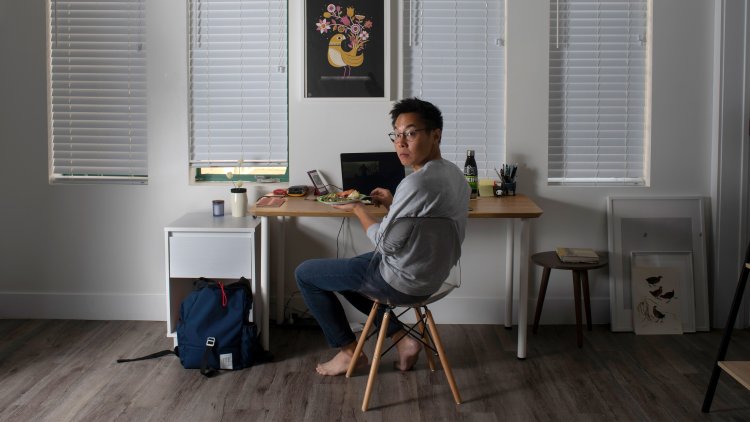America’s Loneliness Has a Concrete Explanation
Dining space is dying.

The dining room is the closest thing the American home has to an appendix—a dispensable feature that served some more important function at an earlier stage of architectural evolution. Many of them sit gathering dust, patiently awaiting the next “dinner holiday” on Easter or Thanksgiving.
That’s why the classic, walled-off dining room is getting harder to find in new single-family houses. It won’t be missed by many. Americans now tend to eat in spaces that double as kitchens or living rooms—a small price to pay for making the most of their square footage.
But in many new apartments, even a space to put a table and chairs is absent. Eating is relegated to couches and bedrooms, and hosting a meal has become virtually impossible. This isn’t simply a response to consumer preferences. The housing crisis—and the arbitrary regulations that fuel it—are killing off places to eat whether we like it or not, designing loneliness into American floor plans. If dining space keeps dying, the U.S. might not have a chance to get it back.
The apex predator of the dining room is the “great room”—a combined living room and kitchen, bridged by an open dining space. “It’s not that Americans don’t want dining rooms. It’s that they want something else, and that takes up space,” explains Stephen Smith, the executive director of the Center for Building in North America, a nonprofit that advocates for building-code reform. “In a single-family home, that’s a great room. And so that’s what developers build.”
[Read: The curse of an open floor plan]
According to surveys in 2015 and 2016 by the National Association of Home Builders, 86 percent of households want a combined kitchen and dining room—a preference accommodated by only 75 percent of new homes. If anything, the classic dining room isn’t dying fast enough for most people’s taste.
The transition from the classic dining room to the great room mirrors the changes in gender norms and family formation that have occurred over the past 125 years. The dining room emerged in the early 20th century, when an ascendant upper middle class hired migrant laborers as servants. Many American homes from that era were designed around creating a separate sphere for “the help,” with sectioned-off kitchens, laundry rooms, and servants’ quarters. You can still find anachronistic allowances for servants’ quarters tucked away in zoning codes that otherwise ban secondary units.
In households where servants were unaffordable, domestic work fell to women. Separate dining rooms and kitchens thus reinforced the segregation of male and female spaces, while allowing generations of newly minted homeowners to ape the design norms of yesteryear’s elites. Women today still do most of the cooking and cleaning, but as dining rooms and kitchens fuse with living rooms, more members of the household spend time in all of those spaces—and even take on a little more of the labor.
If dining space is merging with other rooms in single-family homes, it’s vanishing altogether from newly constructed apartments. Americans might not mind what’s happening to their houses, but the evolution of apartments is a more complicated story.
“For the most part, apartments are built for Netflix and chill,” Bobby Fijan, a real-estate developer and floor-plan expert, told me. “The reason the dining room is disappearing is that we are allocating [our] limited space to bedrooms and walk-in closets.” Even though we’re dining at home more and more—going to restaurants peaked in 2000—many new apartments offer only a kitchen island as an obvious place to eat.
This is partly a response to shrinking household size. According to the U.S. Census Bureau, the share of one-person households more than tripled from 1940 to 2020. A dedicated dining space might feel wasted on someone who lives alone. And for young, unmarried apartment dwellers with only a roommate or two, developers typically sacrifice a common dining space in order to maximize personal space.
As households and dining spaces have contracted, the number of people eating alone has grown. According to a 2015 report by the Food Marketing Institute, nearly half the time we spend eating is spent in isolation, a central factor in America’s loneliness epidemic and a correlate to a range of physical- and mental-health problems.
Do we want to live this way—or do we have to, thanks to America’s housing supply? “It’s a chicken-and-an-egg problem,” Fijan said. How many more dinners would be shared if we had the space to host guests?
Stephen Smith doesn’t buy that the death of dining space is purely a function of consumer preferences. In most U.S. cities, he told me, building codes mandate double-loaded corridors—or two rows of apartments along a hall—making larger units difficult to build. “When you can only build small apartments with one wall of windows, rooms will naturally disappear,” he said. “Nobody wants a dining room without a window.”
[M. Nolan Gray: Cancel zoning]
In cities across the country, apartments are shrinking, even as single-family homes continue to grow. The difference is that many of the former are subject to arbitrary zoning rules that limit the total amount of floor area that can be built—in places where apartments can be built at all. Combine an acute housing shortage with tight zoning rules (as in cities such as New York and Los Angeles), and you end up with a lot of tiny apartments and few dining rooms.
In an age when Americans are spending less and less time with one another, a table and some chairs could be just what we need. For what it’s worth, scientists have begun to think that the appendix does have a use—as a reservoir for healthy gut bacteria. Dining rooms should be so lucky.
What's Your Reaction?




















